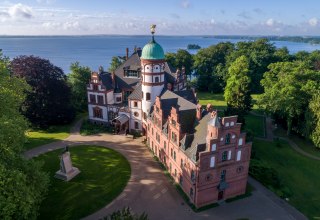The College Building I in Schwerin, close to the castle and facing Schloßstraße, was built on the orders of Friedrich Franz I. The classicist three-winged complex impresses with a terraced courtyard of honor, an impressive portal and a magnificent staircase. Materials from the former Franciscan monastery may have been used in its construction. The adjoining Kollegiengebäude II, built between 1890 and 1892 by Georg Daniel, is connected by a three-part triumphal arch. It features a central inner courtyard, stucco ceilings and preserved door systems. Both buildings are important examples of classicist architecture in Schwerin.
The College Building I in Schwerin was built on the orders of Frederick Francis I near the castle and faces Schloßstraße. The southern side wing looks towards the Old Garden. The site was previously occupied by a Franciscan monastery, which was dissolved during the Reformation in 1548; materials from the former monastery may have been used in the construction of the college building.
The classicist three-winged complex impresses with its terraced courtyard and a façade reminiscent of Karl Friedrich Schinkel's Berlin Schauspielhaus. In the center rises an impressive portal with an altar and a portico. The outer wings are decorated with striking triangular gables and sandstone figures by the artist Emil Cauer.
The magnificent staircase with its cast-iron elements is particularly noteworthy, while the Cabinet Hall and the College Hall on the upper floor boast richly inlaid parquet flooring.
The Kollegiengebäude II, built between 1890 and 1892 by Georg Daniel, is an extension and comprises a three-storey building with a central courtyard. The two buildings are connected by a three-part triumphal arch, which is still used by administrative staff today. Compared to the Kollegiengebäude I, the façade of the extension has a reduced design. The interior features stucco ceilings and pilasters, while the richly designed doors have been preserved.
Overall, the Kollegiengebäude I represents an important example of neoclassical architecture in Schwerin and reflects the architecture of its time. Since 1990, the Kollegiengebäude I has been the state chancellery of the Minister President of Mecklenburg-Vorpommern.




















